This is a Sears TLS, a 35mm SLR camera sold by the US department store chain Sears, Roebuck, & Company starting in 1967 through at least 1971. The TLS was made by, and is a name variant of the Ricoh Singlex TLS which is how the camera was sold in other markets. The Sears TLS is a robust and heavy mechanical camera featuring a through the lens CdS exposure meter that supports stop down metering using the M42 mount. Apart from requiring lenses that support automatic diaphragms, the metering system on the TLS could be used with screw mount lenses made by any manufacturer. The Sears TLS was a pretty basic camera sold to beginning photographers who didn’t need a whole lot of bells and whistles.
Film Type: 135 (35mm)
Lens: 55mm f/1.4 Auto Rikenon coated 7-elements in 5-groups
Lens Mount: M42 Screw Mount
Focus: 1.6 feet / 0.5 meters to Infinity
Viewfinder: Fixed SLR Pentaprism, 95% Field of View, 0.8x Magnification
Shutter: Vertically Travelling Focal Plane
Speeds: B, 1 – 1/1000 seconds
Exposure Meter: Coupled Through the Lens CdS Cell w/ viewfinder match needle
Battery: 1.35v PX625 Mercury Battery
Flash Mount: Clip on Cold shoe and M and X Flash Sync
Other Features: Self-Timer
Weight: 1064 grams, 752 grams (body only)
Manual: https://www.cameramanuals.org/sears/sears_tls.pdf
How these ratings work |
The Sears TLS was a simple, and rugged camera, made with a clean and utilitarian design whose sole purpose was to make photos. With a match needle exposure meter, you have the benefit of exposure help, a large and bright viewfinder makes focus and composition easy, and with the excellent Riken made f/1.4 lens, you are guaranteed sharp and contrasty looking images. The Sears TLS is a no nonsense and reliable fully mechanical 35mm SLR. | ||||||
| Images | Handling | Features | Viewfinder | Feel & Beauty | History | Age | |
| 2 | 1 | 1 | 2 | 1 | 1 | 20% | |
| Bonus | None | ||||||
| Final Score | 9.6 | ||||||
History
Ever since the early 20th century, the US department store chain Sears, Roebuck, & Company sold cameras made by other people. Around the turn of the last century, the first company I could find whose products appeared in Sears catalogs were those by the Rochester Optical & Camera Company. In either 1903 or 1907 (two different sources conflict with each other), after Rochester was purchased by Eastman Kodak, Sears started offering cameras, lenses, and other photographic goods by the Conley Camera Company out of Spring Valley, Minnesota. Sears would also offer products by a variety of other manufacturers at this time, but in most cases, rebranded them under their own Seroco brand.
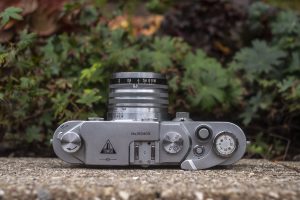
Over the next couple of decades, Sears would continue this practice, selling a huge number of cameras and photographic goods by companies from America, Germany, and Japan. Although some cameras sold by Sears would retain their original names, Sears would often rebrand them with their own “house name”. The most famous were its Tower branded cameras sold in the 1950s and 60s which included cameras made by major brands like Asahi (Pentax), Olympus, and Mamiya. The Sears page on camera-wiki.com has a comprehensive list of a huge number of Sears branded cameras and who they were made by. Looking at the list, it is far from complete but it currently stands at over 120.

At some point around 1962, Sears stopped using the Tower brand name for their cameras and instead sold most models simply as Sears. In the mid 1960s, Sears started offering its first models by Ricoh, another Japanese maker of photographic products.
The first Ricoh models were simpler rangefinders like the Sears RF-5, but more advanced rangefinder models like the Sears ES 35, a rebranded Ricoh Super Shot were available. By the end of the 1960s, more and more Ricoh cameras were sold by Sears, many of which were Single Lens Reflexes. At this time, Ricoh became Sears, Roebuck, & Company’s primary source for 35mm Single Lens Reflex cameras.

In 1967 a Ricoh model called the Singlex TLS was sold by Sears simply as the Sears TLS. As was the case with most Sears branded cameras, the TLS was identical to its Japanese twin, the only difference was in the name plate. The Sears TLS was a well built, but modest camera featuring the M42 screw mount and a through the lens CdS exposure meter with stop down metering. It had all the usual features of a late 1960s SLR including a rapid advance lever, instant return mirror, and a bright etched focusing screen. Included with the TLS were some of Ricoh’s excellent Rikenon lenses.
In 1967, the Sears TLS appeared in the Sears Spring/Summer catalog with a 55mm f/1.4 Auto Sears lens for $197.00. The camera was not available body only, but wide angle and telephoto lenses were sold in the same catalog $68.50 each. Of course the camera using the “universal” M42 lens mount meant that any screw mount SLR lens made for any other screw mount camera would also work. In addition to being offered as the Sears TLS, Ricoh would also rebrand this camera for another US department store chain, K-mart, as the Focal 1000 TLX and for the European retailer Porst as the Porst Uniflex TTL and under a variety of other names such as the Chinonflex TTL, Revueflex 1000S TTL, Revue Superflex TTL, Riaflex TTL, and the Prinzflex Super TTL.
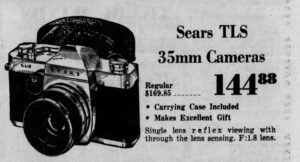
As was typical of the time, although carrying a catalog price of nearly $200, the actual street price of the camera was usually much lower. In a Sears advertisement from December 1967, the camera was advertised for $144.88 which when adjusted for inflation, compares to a little over $1300 today.
I could not find any contemporary reviews of the Sears TLS from this era as it was not common for department store cameras to receive attention in major photographic publications. That the Ricoh Singlex TLS was a relatively simple camera aimed at amateur photographers new to SLRs, it wouldn’t have received much fanfare, but a combination of good build quality, a great lens, modern TTL metering, and support from one of the largest US retailers, the Sears TLS seemed to have sold well as it was produced at least until 1971.
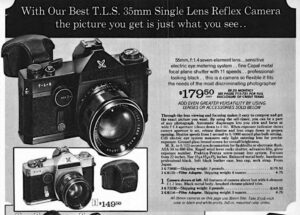
In 1971, a blacked out version with new cosmetics was released, still as the Sears TLS with the same feature set, and the same lens. Although mechanically the same as the original model, the new TLS model carried a catalog price of $179.50, but a chrome version was also available for $149.50. The higher price of a black model was consistent with other camera makers charging a premium for black painted cameras as they were perceived by the public to be “professional” models.
In addition to the new black paint, the camera received a new stylized SR logo that blended the letters “S” and “R” with the design of an atom. In addition, a narrow strip of body covering was on the front face of the prism, not entirely unlike the Leicaflex SLRs of the same era. Although completely cosmetic, they gave the camera a bit of a upscale, luxurious look.
It is unclear how long after its redesign the Sears TLS remained in production. Based on its limited feature set, I have to assume not very long as many, much more advanced SLRs were already available on the market with more to come. It would have likely been difficult to keep selling cameras like the TLS for much longer.
Sears would continue its relationship with Ricoh throughout the 70s and release a large number of rebadged SLRs from Ricoh’s KR and XR series. These cameras were significantly more advanced than the earlier Sears TLS model featuring electronic shutters, automatic exposure, and the new Pentax K-mount.
As the years passed and consumer spending habits shifted, Sears became less and less of a go to resource for cameras and photographic goods. Although the company still exists today, it has been years since Sears has sold a house brand camera. Upon looking at the 2023 sears.com website, the company still offers cameras, but they’re the same products sold online on any other number of consumer electronics websites.
Today, there’s not likely many people who would specifically seek out a Sears branded camera. Models like the Sears TLS are no different than the original Ricoh versions and that they were always entry level cameras aimed at the novice photographer, they rarely have much appeal to collectors. If however, you are in the market for a solid, reliable, but easy to use mechanical camera, models like the TLS might be worth considering, especially at the low prices they usually fetch in the used market.
My Thoughts
There’s the saying “sometimes less is more”, or the other saying that “it is better to do one thing really well than do many things half assed”, I am sure there’s another saying out there I could quote, but the point I want to make here is that there are times in life where were need to remove complications and go for simpler methods to doing things.
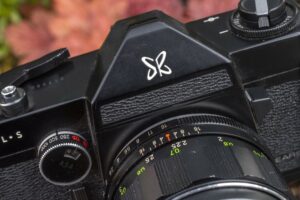
When it comes to shooting photography, there are many different ways in which you can take a simple concept and make it difficult. In a way, shooting film cameras in 2023 is in itself over complicating something that I could easily accomplish with a simpler digital camera, but that’s not why I shoot film.
But if you’re like me, and still want to shoot film, but in the simplest way possible, you need a camera that breaks it down to the basics, a simple, yet reliable camera, with minimal bells and whistles, but just enough modern conveniences to not slow you down too much. Enter the Sears TLS.
The Sears TLS is simply a rebadged Ricoh Singlex TLS and having shot Ricoh cameras before, I figured the lens would be great and the camera would be well built. When the TLS showed up, I marveled at how good of condition this example was. The camera and lens tipped the scales at 1064 which puts it well within Nikon F-body weight, yet the camera had excellent balance. The large 7 element f/1.4 Rikenon didn’t cause the camera to feel front heavy and when placed on a flat surface, the camera didn’t tilt forward like some other heavy lens cameras do.

Up top, there’s surprisingly little to see. The short list of features and that the shutter speed dial is on the front of the camera means that the number of controls on top are kept to a minimum. On the left is the rewind knob with folding handle and a simple film reminder dial. Although the camera does have a meter, this dial has no effect on it. The top of the prism lacks an accessory shoe as the only way to attach a flash to the camera was via an optional clip on shoe that mounted to the eyepiece.
To the right of the porism is a large blank void where a shutter speed dial would appear on many other SLRs, a cable threaded shutter release, the automatic resetting exposure counter and film advance lever. The advance lever is painted black like the body, and has a relatively short throw, reaching its maximum a little over 100 degrees after its stand off position. The tip of the lever has no plastic coating and is made of sharp metal which can dig into your fingers if you don’t handle it right.
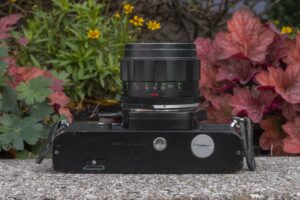
The bottom plate of the camera is just about as bare as the top, with only the centrally located 1/4″ tripod socket, rewind release button and the round opening for the battery compartment. The Sears TLS is an entirely mechanical camera and only needs a single PX625 mercury battery to operate a meter. I am unsure of the camera has a stepping circuit to limit voltage, but I found that using a modern 1.5v alkaline equivalent still got me accurate meter readings while testing the camera.

Around back, there’s the rectangular eyepiece for the viewfinder and nothing else. On the camera’s left side are two PC flash sync ports, one for M and one for X, and on both sides are diagonally forward facing metal strap lugs. The orientation of the strap lugs help to prevent the camera from tilting forward while it dangles from your neck. Beyond the lugs and flash sync ports, there’s nothing else to see.

Opening the film door is done by pulling up on the rewind knob and giving it a tug. The right hinged door opens to reveal an ordinary film compartment. Film transports from left to right onto a non removable plastic, double slotted take up spool. The spool rotates clockwise which means the film wraps around it opposite of how it is rolled in the cassette which is said to help with film flatness. Inside the film door is a large black metal pressure plate covered in many divots which help reduce friction as film transports over it. On the left is a chrome tab to help stabilize the cassette while loaded, and a sticker reminding you to turn the meter switch off when not in use. The inside of the door and the channels above and below the film compartment originally came with foam light seals which on this camera had degraded and become compromised. I ended up replacing the light seals with ones I made before shooting the camera to keep out light leaks.
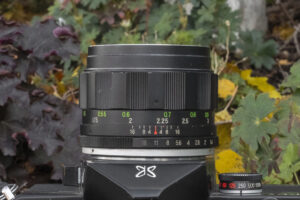
Looking down a top the Rikenon lens, closest to the body is the aperture ring with click stops from f/1.4 down to f/16. A separate lever near the bottom of the lens switches the lens from having an automatic diaphragm to having a manual one. You can temporarily move this lever to the manual position to preview depth of field, but otherwise you’d want to keep the lens in automatic mode all other times. In front of the aperture ring is a depth of field scale and then the wide metal focus ring. Focus from minimum to infinity requires about 3/4 of a full turn. Minimum focus on this lens is slightly under 1.75 feet (in white) or 0.5 meters (in green).
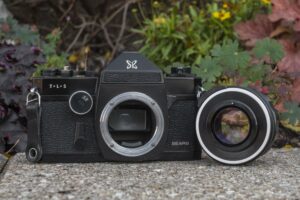
The Sears TLS uses a simple screw mount, so removing the lens is as easy as rotating it counterclockwise to remove it and clockwise to put it back on. Above and to the left of the lens mount is the combined film speed and shutter speed dial. Shutter speeds from 1 to 1/1000 second plus Bulb are obtained by rotating the outer dial, and film speeds from ASA 20 to 1600 are obtained by pulling forward on the outer ring and turning just that. A small forward facing window shows which film speed you have selected. Below the shutter speed dial is a mechanical self timer lever which activates an approximate 8 second delay before firing the shutter. Strangely, a full motion of the self timer lever requires only about 1/8th of a turn. The self-timer cannot be cancelled and is tripped when pressing the shutter release.

The final feature on the front of the camera is on the side of the mirror box facing the camera’s left side (from the photographer’s perspective). This switch functions similarly to the meter switch on the Pentax Spotmatics in which when the meter is off, the lens is left wide open so you may compose through the viewfinder at maximum aperture. As the meter on the Sears TLR only works in stop down mode, pressing up on the meter switch to turn it on, also stops down the lens. This means that the lens diaphragm will stop down to whatever f/stop is selected on the lens, which also darkens the viewfinder. This is why it is important to compose your image before activating the meter. You can still compose your image with the meter on, but the viewfinder will get progressively darker, the smaller f/stop you use.
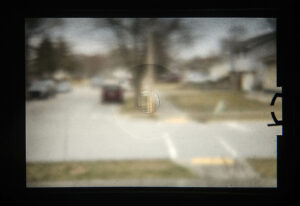
The viewfinder has a standard match needle display on the right side of the focus screen. With the meter on, there is an upper and lower part of the match display with an opening in the middle. Only with the needle pointing to the opening will proper exposure be made. The meter is coupled to the shutter and film speed dial and will change as you change it. The meter isn’t technically coupled to the lens, but since the meter on switch also stops down the lens, as you change f/stops, the amount of light will be accurately taken into account with the meter reading.
The rest of the viewfinder is pretty bare, featuring only a microprism circle in the center and a ground glass collar around it. Outside of the collar is an extremely fine matte viewing screen which is unusually bright for a 1960s SLR. With the f/1.4 Rikenon lens wide open, I was able to easily see focus on the entire focusing screen, even in dim lighting. Little to no darkness appears in the corners, suggesting some type of Fresnel pattern is there, although I couldn’t see it.
The Sears TLS isn’t a camera that is going to excite too many collectors or film shooters today. By far, its greatest strength is in its utilitarian design, ergonomics, and use. When this camera was released, it was a large and heavy, no nonsense camera built to use a large number of good to great M42 screw mount lenses, but with the modern conveniences of an exposure meter and a bright viewfinder. Today, it is still a large and heavy, no nonsense camera built to use a large number of good to great M42 screw mount lenses, but with the modern conveniences of an exposure meter and a bright viewfinder. Whether you’re looking to get into film photography for the first or millionth time, the Sears TLS is an easy to use and dependable mechanical SLR that does everything you need, and nothing you don’t.
My Results
I first picked up the Sears TLS as I liked the blacked out look and the SR “atomic” logo, but once the camera arrived, the reality set in that I just bought a very basic late 1960s Japanese SLR with an uninspiring feature set, stop down match needle exposure meter, a mechanical shutter, and not much else. There were literally hundreds of other models made around this same time with the same feature set, so I knew that if I were to shoot the camera, I wouldn’t be in for much of a thrill ride.
In an effort to get me excited to shoot the camera, I went through my junk drawer of film loaded with one off rolls I’ve come across in lots of other things which I have accumulated over the years and pulled out a single roll of expired Kodak 5069 High-Contrast Copy Film. I only had one single roll, but from what little I could find online about it, the film should be rated at a speed of about ASA 25 and likely would still be viable despite its unknown expiration date. I loaded the film into the Sears TLS and took it out.
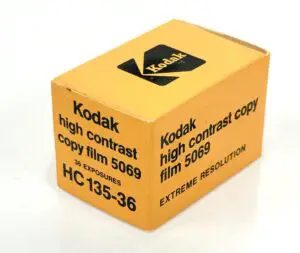
Even though this is a camera review, I’ll start out by saying this might be the most distinct looking film I’ve ever shot. As the name suggests, this is definitely high contrast film, that likely was never intended for photographic use. Like most high contrast slow speed films, grain was extremely fine, giving an almost unnatural smoothness to the light and dark areas. Images would often show blown out highlights and muddy blacks in the same image. In the gallery above, I made adjustments to every single photo to boost the shadows and tame the highlights. I didn’t push it too far, but it was enough to salvage some level of shadow detail that straight development likely wouldn’t have shown.
Another characteristic of this film is that it did best with a tad bit of underexposure. Images like the one of the car’s rear mirror, the the outdoor roadside shot were probably overexposed by +1, yet almost the entire image was blown out. With only a single roll of this stuff to use, I couldn’t do more tests, but I would gather that the film has very little latitude. Even at ASA 25, it was easy to blow out the whites outdoors. Despite these challenges though, I really liked the look of the images, and with the fast f/1.4 maximum aperture, I was still able to get really nice indoor pics like my mirror selfie, without having to stabilize the camera. I definitely like the look of this 5069 film and hope to come across more in the future.
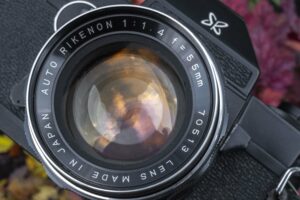
As for the camera, as I expected, the Sears TLS was a pretty unremarkable camera to shoot. The lens definitely stole the show as the 7-element Rikenon f/1.4 produced excellent results. As I shot a good number of these images wide open, I did notice some softness near the corners in a few images, but in the ones where I know I stopped the lens down, the images are sharp corner to corner. I definitely believe that had I been using more normal film, with apertures in the lens sweet spot, these would be extremely sharp and clear images.
Another positive for the camera was how bright and easy to use the viewfinder was. Cameras from the late 1960s and very early 70s were still before the era of “guaranteed bright” viewfinders. While many A-list companies like Nikon and Canon were already making SLRs with very bright focus screens, there were still plenty of B and C-list makers with dim screens, but thankfully, that wasn’t an issue with the Ricoh made Sears TLS.
The meter on the camera is designed to be powered by a 1.35v Mercury PX625 battery which is no longer available, so I did use a 1.5v alkaline equivalent. It is possible that the over exposure I got in a few images might have been due to a difference in voltage, but I don’t think so. The film I used in my test had very little latitude, and it is very possible that user error resulted in a few blown out shots. I can’t say for sure whether or not the camera has a stepping circuit to correct the voltage difference of a modern battery or not, but at the very least, I would say that had I used an actual photographic film with more latitude, that whatever differences there were would likely be unnoticeable.
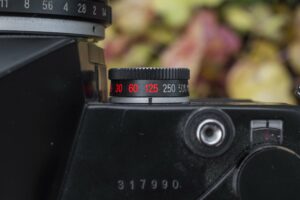
I could probably make a whole list of complaints about things the camera couldn’t do, but understanding that this was always meant to be a rudimentary and simple camera, I found myself enjoying the camera more than I expected. Its clean lines made it easy to hold, and the heavy body inspired confidence while shooting it. Back to how I started out the previous section, less is more, and that certainly applies here as my fondness for the Sears TLS continued to grow as I shot it.
If I had to come up with some minor nitpicks, I’d say the shutter is very loud. The camera could definitely have benefitted from some internal sound dampening materials, as the cacophony of metal blades and mirrors slapping around would make most librarians frown. I found the tip of the film advance lever to be a bit sharp, as it dug into my thumb a couple times while advancing the film. Finally, I didn’t really love the front mounted shutter speed dial, but I can’t really give you a good reason why. There’s certainly nothing wrong with it, but I guess I would have preferred one in the normal location.
Overall, I’d say the Sears TLS is one of those cameras that is better than the sum of its parts. On paper, this is a pretty basic camera with features consistent with a dozen or more similar cameras made around the time of its release. When I first loaded up the camera for its first roll, I wasn’t that thrilled to be using it, but the more time I spent with it, the more I enjoyed it. I found that despite its large size, the camera was quick and very comfortable to use, and after a few exposure, it disappeared almost as if the camera was an extension of myself. I can’t sit here and tell you to run right out and buy one of these cameras, but I won’t tell you not to either. If however, you already have a Sears TLS and have shot it, then chances are, you have a soft spot for it for the same reasons I now do too.
Related Posts You Might Enjoy
External Links
http://camera-wiki.org/wiki/Sears_TLS
https://mattsclassiccameras.com/slr/sears-tls-ricoh-singlex-tls/
https://cameracollector.proboards.com/thread/1162/sears-tls
https://munk.org/typecast/2022/01/09/1971-sears-t-l-s-my-favorite-all-manual-all-metal-brick-camera/
https://www.photo.net/forums/topic/393400-sears-tls-black-is-back/


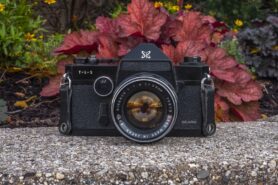
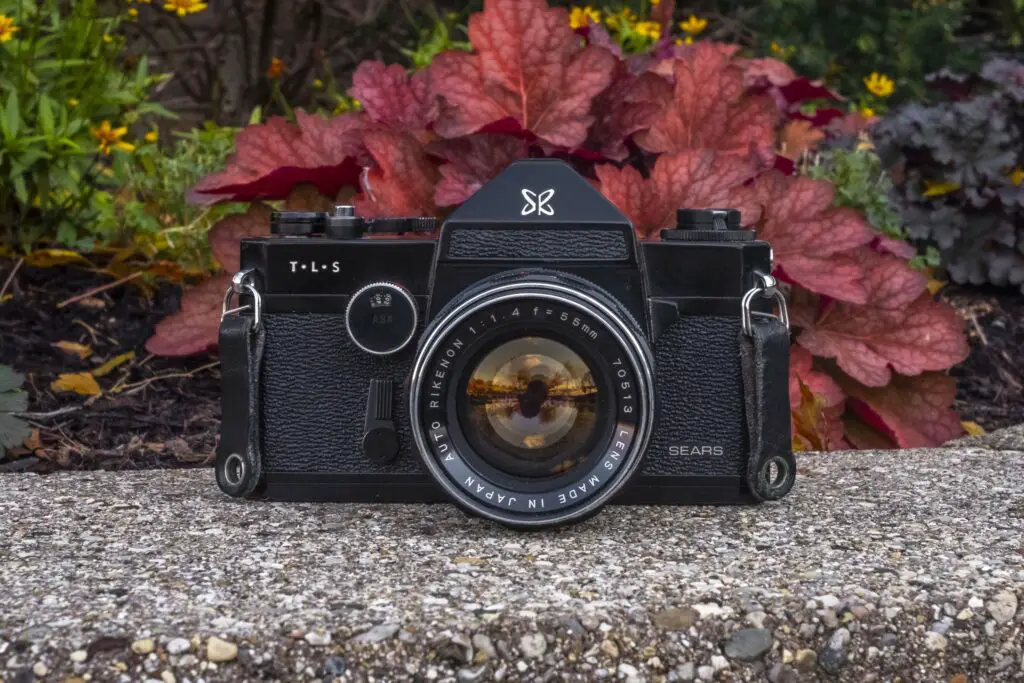
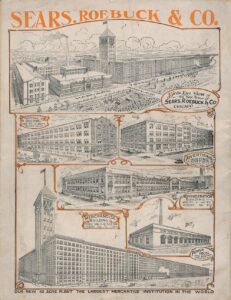

















Praktica sold an SLR with very similar specifications to the Sears, right up to 1989.
Have two and would say “nothing special” besides the Ricoh variants. Although the Singlex II is pretty nice.